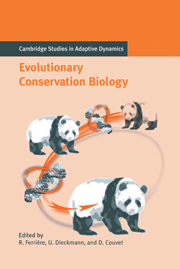Book contents
- Frontmatter
- Contents
- Contributing Authors
- Acknowledgments
- Notational Standards
- 1 Introduction
- Part A Theory of Extinction
- Part B The Pace of Adaptive Responses to Environmental Change
- Part C Genetic and Ecological Bases of Adaptive Responses
- Part D Spatial Structure
- Part E Community Structure
- 16 Coevolutionary Dynamics and the Conservation of Mutualisms
- 17 Ecosystem Evolution and Conservation
- 18 The Congener as an Agent of Extermination and Rescue of Rare Species
- 19 Epilogue
- References
- Index
- The International Institute for Applied Systems Analysis
19 - Epilogue
Published online by Cambridge University Press: 15 August 2009
- Frontmatter
- Contents
- Contributing Authors
- Acknowledgments
- Notational Standards
- 1 Introduction
- Part A Theory of Extinction
- Part B The Pace of Adaptive Responses to Environmental Change
- Part C Genetic and Ecological Bases of Adaptive Responses
- Part D Spatial Structure
- Part E Community Structure
- 16 Coevolutionary Dynamics and the Conservation of Mutualisms
- 17 Ecosystem Evolution and Conservation
- 18 The Congener as an Agent of Extermination and Rescue of Rare Species
- 19 Epilogue
- References
- Index
- The International Institute for Applied Systems Analysis
Summary
“Ecologists traditionally have sought to study pristine ecosystems to try to get at the workings of nature without the confounding influences of human activity. But that approach is collapsing in the wake of scientist's realization that there are no places left on Earth that don't fall under humanity's shadow” (Gallagher and Carpenter 1997).
Introduction
Indeed, the preoccupation of evolutionary ecologists with the pristine reflects a long tradition in western culture and a philosophy that separated humanity and nature (Latour 1999; Gould 2000; Western 2001).
As highlighted by the quote above, currently a large fraction of the world's ecosystem structure and dynamics is dominated by human effects (Vitousek et al. 1997; Palumbi 2001). By the 20th century, domestic production and settlement had visibly transformed nearly half of the world's land surface, and as we enter the 21st century, human activity is altering biogeochemical cycles and climate on a global scale (Hammond 1998; Western 2001). As a consequence, we must face the prospect of large-scale extinctions in the near future. While this could become comparable in magnitude to some of the catastrophic mass-extinction events of the past, the current biodiversity crisis has a unique feature: humankind as the primary cause. The threat is intrinsic, and because the originator of the trauma has a presumed capacity to mitigate its own deleterious impact, conservation action may be warranted (Novacek and Cleland 2001).
- Type
- Chapter
- Information
- Evolutionary Conservation Biology , pp. 356 - 364Publisher: Cambridge University PressPrint publication year: 2004



